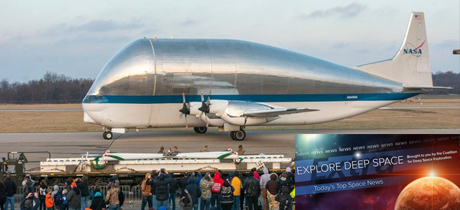In Today’s Deep Space Extra… This month’s annual SpaceCom gathering offered an optimistic outlook for future space exploration with the commercial sector and international partners. Will the White House and Congress work together to ensure U.S. leadership in the endeavor? Marshall Space Flight Center lab certified to assess Space Launch System (SLS) integration for Artemis missions.
Human Space Exploration
Watch: NASA’s Super Guppy delivers Orion spacecraft to Ohio airport
Geek.com (11/25): The Orion spacecraft for Artemis 1, which is being transported by NASA’s Super Guppy aircraft, safely arrived at Mansfield Lahm Regional Airport in Ohio yesterday. Members of the public were invited to check out the cool space technology and learn about NASA’s Artemis program, which aims to place the first woman and the next man on the moon by 2024.
NASA certifies SLS rocket lab to test flight software for Artemis I
Astrotech News (11/25): Earlier this month, the Systems Integration Laboratory at NASA’s Marshall Space Flight Center received certification for testing and evaluation of the avionics and software for Space Launch System (SLS) missions. The lab houses flight computers and avionics identical to those of the SLS core stage as well as emulators for the rocket’s boosters and engines, the Launch Control Center and the Orion capsule primary payload.
Space Science
Russian space agency plans to place telescopes on Moon to track dangerous asteroids
TASS of Russia (11/25): Russia’s plans for a base at the south pole of the Moon include an observatory equipped to detect and track asteroids and comets that pose an impact threat to the Earth, Alexander Bloshenko, the Russian space agency’s executive director for science and long-term programs, told the Russian news agency.
Jupiter’s Great Red Spot storm isn’t dying anytime soon
Space.com (11/25): Researches find the Jupiter’s famous Great Red Spot, a long lived atmospheric storm, will churn on.
Op Eds
Will Artemis fail in the halls of Congress?
The Space Review (11/25): The fate of the Trump Administration’s accelerated efforts to return humans to the surface of the Moon in 2024 could fail based on a lack of communication with Congress on the costs and perhaps geopolitical factors, according to an assessment from Jonathan Coopersmith, professor in the Department of History at Texas A&M University. Artemis could become a bargaining tool, possibly meeting the same fate as President George H.W. Bush’s late 1980’s Space Exploration Initiative and President George W. Bush’s 2004 Vision for Space Exploration, he cautions.
An exciting time for international space
Aerospace Industry Association (11/12): Last week’s two day annual SpaceCom conference and exposition in Houston painted a favorable outlook for a global space economy. There are new markets on the frontier, remote satellite servicing, for instance, and the more familiar human suborbital space passenger travel. Still, the U.S. must make some key moves to ensure its position of leadership in the market, including extending the life of the International Space Station (ISS) beyond 2024 and committing soon to the participation of international partners in the assembly of a lunar orbiting, human tended Gateway, writes Mike French, the AIA’s vice president for space systems and an AIA participant.
Global government space budgets continues multiyear rebound
SpaceNews.com (11/25): Figures from Europconsult’s Government Space Programs 2019 report reveal that global government spending on space programs reached $70.9 billion in 2018, reflecting a five year compound annual growth rate of 5.75 percent. The report reflects a continued global growth in government spending in the field since a 2015 low of $62.5 billion.
The myth of the “new space race”
The Space Review (11/25): If there is a new space race, it’s not between the U.S. and China, writes Benjamin Charlton, a senior Asia-Pacific Analyst at Oxford Analytica, a geopolitical analysis and consulting firm. The U.S. has a clear lead in space, and neither the U.S. nor China seems eager to conquer the solar system on urgent time scales. The actual race in space is unfolding within the commercial sector, according to Charlton.
Building a planet B for humanity isn’t a good enough reason to explore space
Space.com (11/25): Canadian anthropologist Kathryn Denning questions the soundness of a race to settle Mars or elsewhere in the solar system as a potential refuge for humans should the worst happen to Earth. Such an enterprise would require a fully sustainable civilization on Earth to support the move, she argues.
Other News
Commercial spaceports increase focus on economic development
SpaceNews.com (11/26): An enthusiasm for startup spaceports across the U.S. continues, largely to take advantage of a promising future space economy, a topic for discussion at last week’s meeting of the Global Spaceport Alliance in Houston as part of the annual SpaceCom conference and exposition. Some face a long wait for even a first launch. Licensed in 2015, the Houston Spaceport, for instance, is focused on aerospace innovation and economic development for the foreseeable future.
Russia launches space surveillance satellite
Spaceflightnow.com (11/25): Northern Russia’s Plesetsk Cosmodrome was the site Monday for the launch of a classified Russian military satellite atop a Soyuz 2-1v rocket with a Volga upper stage. The satellite’s mission may be the surveillance of other Russian satellites from polar orbit.

